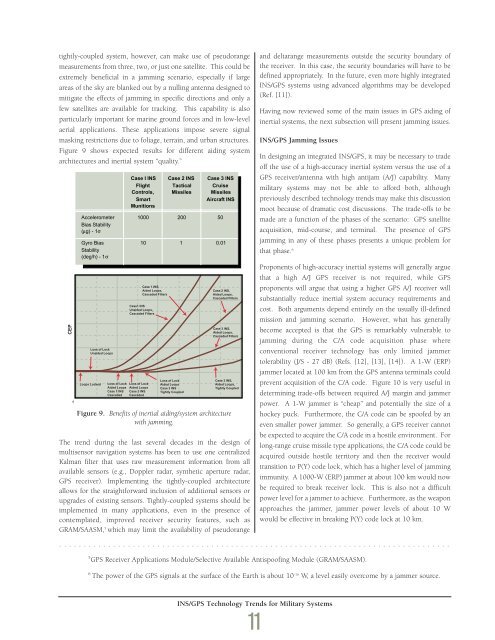1998 - Draper Laboratory
1998 - Draper Laboratory
1998 - Draper Laboratory
- No tags were found...
You also want an ePaper? Increase the reach of your titles
YUMPU automatically turns print PDFs into web optimized ePapers that Google loves.
tightly-coupled system, however, can make use of pseudorangemeasurements from three, two, or just one satellite. This could beextremely beneficial in a jamming scenario, especially if largeareas of the sky are blanked out by a nulling antenna designed tomitigate the effects of jamming in specific directions and only afew satellites are available for tracking. This capability is alsoparticularly important for marine ground forces and in low-levelaerial applications. These applications impose severe signalmasking restrictions due to foliage, terrain, and urban structures.Figure 9 shows expected results for different aiding systemarchitectures and inertial system “quality.”CEP0µ σLoops LockedσLoss of LockUnaided LoopsLoss of LockAided LoopsCase 1 INSCascadedCase1 INSUnaided Loops,Cascaded FiltersLoss of LockAided LoopsCase 3 INSCascadedCase 1 INS,Aided Loops,Cascaded FiltersLoss of LockAided LoopsCase 3 INSTightly CoupledCase 2 INS,Aided Loops,Cascaded FiltersCase 3 INS,Aided Loops,Cascaded FiltersCase 3 INS,Aided Loops,Tightly CoupledFigure 9. Benefits of inertial aiding/system architecturewith jamming.The trend during the last several decades in the design ofmultisensor navigation systems has been to use one centralizedKalman filter that uses raw measurement information from allavailable sensors (e.g., Doppler radar, synthetic aperture radar,GPS receiver). Implementing the tightly-coupled architectureallows for the straightforward inclusion of additional sensors orupgrades of existing sensors. Tightly-coupled systems should beimplemented in many applications, even in the presence ofcontemplated, improved receiver security features, such asGRAM/SAASM, 5 which may limit the availability of pseudorangeand deltarange measurements outside the security boundary ofthe receiver. In this case, the security boundaries will have to bedefined appropriately. In the future, even more highly integratedINS/GPS systems using advanced algorithms may be developed(Ref. [11]).Having now reviewed some of the main issues in GPS aiding ofinertial systems, the next subsection will present jamming issues.INS/GPS Jamming IssuesIn designing an integrated INS/GPS, it may be necessary to tradeoff the use of a high-accuracy inertial system versus the use of aGPS receiver/antenna with high antijam (A/J) capability. Manymilitary systems may not be able to afford both, althoughpreviously described technology trends may make this discussionmoot because of dramatic cost discussions. The trade-offs to bemade are a function of the phases of the scenario: GPS satelliteacquisition, mid-course, and terminal. The presence of GPSjamming in any of these phases presents a unique problem forthat phase. 6Proponents of high-accuracy inertial systems will generally arguethat a high A/J GPS receiver is not required, while GPSproponents will argue that using a higher GPS A/J receiver willsubstantially reduce inertial system accuracy requirements andcost. Both arguments depend entirely on the usually ill-definedmission and jamming scenario. However, what has generallybecome accepted is that the GPS is remarkably vulnerable tojamming during the C/A code acquisition phase whereconventional receiver technology has only limited jammertolerability (J/S - 27 dB) (Refs. [12], [13], [14]). A 1-W (ERP)jammer located at 100 km from the GPS antenna terminals couldprevent acquisition of the C/A code. Figure 10 is very useful indetermining trade-offs between required A/J margin and jammerpower. A 1-W jammer is “cheap” and potentially the size of ahockey puck. Furthermore, the C/A code can be spoofed by aneven smaller power jammer. So generally, a GPS receiver cannotbe expected to acquire the C/A code in a hostile environment. Forlong-range cruise missile type applications, the C/A code could beacquired outside hostile territory and then the receiver wouldtransition to P(Y) code lock, which has a higher level of jammingimmunity. A 1000-W (ERP) jammer at about 100 km would nowbe required to break receiver lock. This is also not a difficultpower level for a jammer to achieve. Furthermore, as the weaponapproaches the jammer, jammer power levels of about 10 Wwould be effective in breaking P(Y) code lock at 10 km.................................................................................5 GPS Receiver Applications Module/Selective Available Antispoofing Module (GRAM/SAASM).6The power of the GPS signals at the surface of the Earth is about 10 -16 W, a level easily overcome by a jammer source.INS/GPS Technology Trends for Military Systems11
















